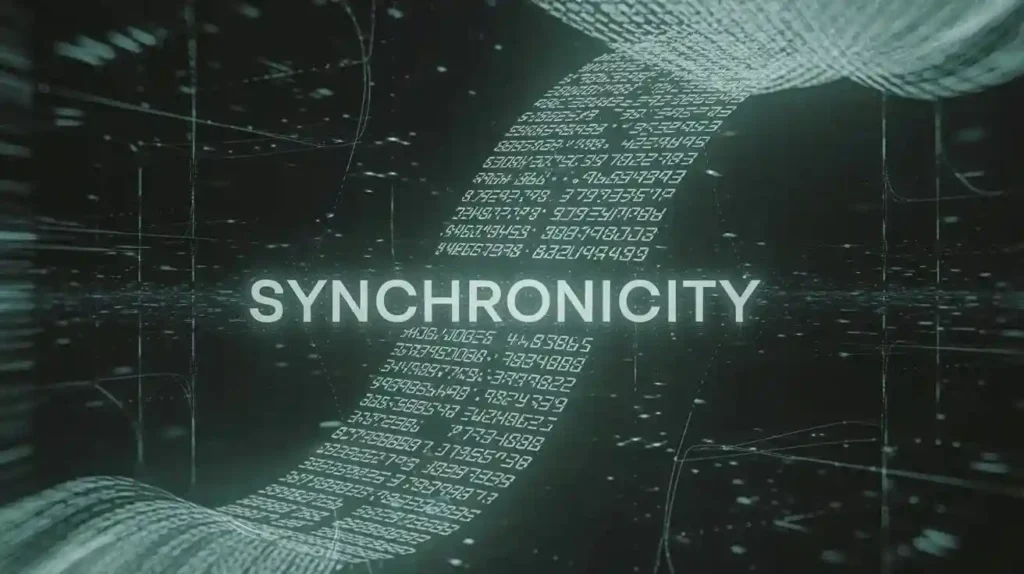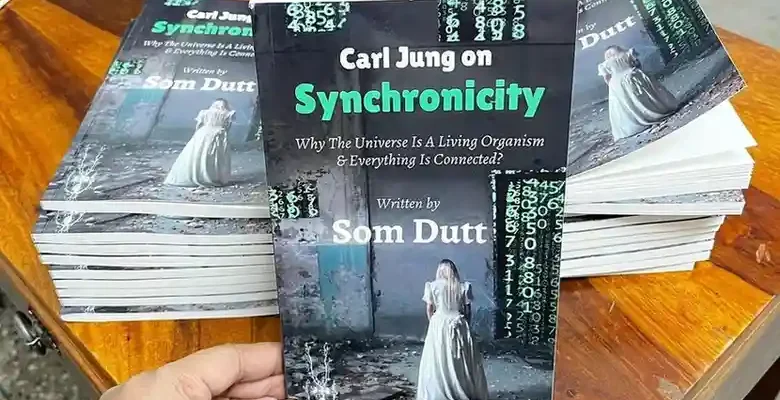Last updated on November 3rd, 2025 at 06:38 am
My this first book “Carl Jung on Synchronicity” is a deep exploration of one of the most alluring concepts from analytic psychology. Quite the opposite of most introductory books.
I picked to write this book after experiencing several uncanny coincidences that left me questioning whether random events truly exist. In this book, I have tried to bridge the gap between Jung’s complex theoretical framework and practical everyday experiences that we all recognize but struggle to explain.
I tried to translate Jung’s dense philosophical concepts into relatable examples without losing their psychological depth. I have addressed common misconceptions about synchronicity while providing fresh perspectives on how these meaningful coincidences function as psychological phenomena rather than mystical occurrences. I tried to challenge readers to reconsider their assumptions about causality and meaning.
My structured approach makes this complex topic approachable for newcomers while offering enough substance to engage serious students of psychology.
Title: Carl Jung on Synchronicity: Why Universe Is A Living Organism & Everything Is Connected?
Author: Som Dutt Buy from amazon.com Now in just $7
This is one of the best book, you will read on Synchronicity.
Genre: Fiction Psychology/Philosophy
Plot: This book explores Carl Jung’s concept of synchronicity and how it impacts our understanding of the interconnectedness of unrelated events, bridging the gap between the subjective inner world and the objective external reality.
One reviewer noted it was presented as a pamphlet format that covers exactly what readers want to know about Carl Jung’s theory of Synchronicity.
Amazon Reviews: 51 Positive reviews with a rating of 4.6/5
Series Information: Standalone work
Page Count: 97
Key Takeaways
- Bridges Eastern and Western Philosophy: My book uniquely connects Jung’s Western psychological framework with Eastern concepts of cosmic consciousness and universal interconnectedness, offering a multicultural perspective often missing from traditional Jungian interpretations.
- Practical Framework for Personal Growth: Readers gain concrete tools for recognizing and interpreting meaningful coincidences in daily life, with guidance on distinguishing genuine synchronistic events from random occurrences for self-discovery purposes.
- Limited Scientific Rigor: The work in this book relies heavily on anecdotal evidence while inadequately addressing alternative psychological explanations like confirmation bias, selective attention, and statistical probability that modern research uses to explain perceived coincidences.
- Best Suited for Beginners: My book serves as an excellent entry point for psychology enthusiasts and personal development seekers, but lacks the scholarly depth required for academic readers or those with extensive Jung background seeking rigorous analysis.
Introduction and Author Context
My Background and Qualifications in Jungian Psychology
I have established myself as a prominent writer on psychology, mental health, Narcissism, and philosophy through work on Medium.com and my blog websites. My expertise in Jungian concepts stems from extensive study of analytical psychology and synchronicity theory. My academic approach combines theoretical knowledge with practical application, making me well-positioned to interpret Jung’s complex ideas for modern readers.
My writing demonstrates deep familiarity with Carl Jung’s collaborative work with physicist Wolfgang Pauli on synchronicity as “An Acausal Connecting Principle.”
“Sometimes, things want to be done but to be done only through you.”
― Som Dutt, Carl Jung on Synchronicity: Why Universe Is A Living Organism & Everything Is Connected?
The Intersection of Personal Experience and Theoretical Analysis
My methodology uniquely combines personal psychological experiences with rigorous theoretical analysis. My writing reveals how synchronistic events have profoundly impacted my own intellectual development, providing with firsthand knowing of Jung’s concepts. This personal connection enables me to translate abstract psychological theories into relatable examples that resonate with readers.
My approach demonstrates how individual psychic states can resonate with external events, creating meaningful connections. My work explores how these archetypal patterns from the collective unconscious influence thoughts, emotions and behaviors, offering readers practical insights into recognizing synchronistic experiences in their own lives.
Content Analysis and Structure
Writing Style and Accessibility
I employ a refreshingly clear writing style that makes Jung’s complex psychological concepts digestible for general readers. You will find how difficult terms like “collective unconscious” and “acausal connecting principle” are explained through relatable examples rather than academic jargon.
Suitability
Psychology enthusiasts will find solid foundational material while philosophy readers gain practical insights into interconnectedness. The content works well for newcomers to Jungian concepts but offers enough substance for more advanced readers seeking fresh perspectives.
Personal development seekers benefit from the self-discovery elements woven throughout. The accessible language and practical examples make it suitable for book clubs or independent study.

Foundational Concepts of Jung’s Synchronicity Theory
Knowing synchronicity requires grasping two revolutionary ideas that challenge how we perceive reality and meaning. These concepts form the backbone of Jung’s most controversial yet interesting psychological theory.
The Acausal Connecting Principle: Beyond Causality and Conventional Science
Jung’s synchronicity operates as an “acausal connecting principle” that links internal psychological states with external events through meaning rather than traditional cause-and-effect relationships. This principle suggests that events can be connected without one causing the other, fundamentally challenging our scientific knowing of how the world works.
The collaboration between Jung and physicist Wolfgang Pauli proved important in developing this concept. Together, they proposed that synchronicity holds equal rank to causality as an explanatory principle, meaning meaningful coincidences deserve the same scientific consideration as traditional causal relationships. This assertion places synchronicity firmly outside conventional scientific frameworks while maintaining its validity as a tool for knowing human experience.
Meaningful Coincidences as Evidence of Universal Interconnection
Synchronistic events reveal deeper universal interconnectedness by demonstrating how internal psychological states can mirror external circumstances in statistically improbable ways. These meaningful coincidences often feel guided by destiny or higher purpose, proposing that individual consciousness participates in a larger cosmic order.
The archetypal patterns embedded in the collective unconscious play a key role in creating these connections. When an individual’s inner psychic state resonates with external events, synchronicity manifests through dreams, symbols, or encounters with specific people.
These experiences bridge the gap between subjective inner reality and objective external circumstances, offering profound insights into unconscious desires, unresolved conflicts, and untapped potential.
The Universe as a Living Organism Framework
The most striking aspect of this book review is how it presents the universe not as a mechanical system but as a breathing, interconnected entity. This model shift that challenges our traditional scientific worldview.
My Unique Perspective on Synchronicity as Evidence of Cosmic Consciousness
What sets this work apart is my bold assertion that synchronistic events serve as direct communications from a cosmic consciousness. Rather than dismissing meaningful coincidences as random occurrences, the book positions them as symbolic messages guiding us toward deeper self-awareness.
You will find how this perspective transforms our relationship with seemingly unrelated events, encouraging readers to view their experiences as part of a larger, conscious pattern rather than isolated incidents that happen by chance.

Connecting Jungian Psychology with Holistic Universal Principles
The book’s greatest strength lies in its ability to bridge Jung’s psychological insights with broader cosmic principles. This connection enriches traditional analytical psychology by embedding it within a universal context where individual psyche and cosmos engage in meaningful dialogue.
You will find how this approach doesn’t abandon scientific rigor but rather expands our knowing of causality to include acausal connections. The integration feels well-researched, making complex theoretical frameworks accessible to readers seeking both psychological insight and spiritual knowing.
Archetypal Patterns and the Collective Unconscious
Jung’s concept of archetypes as universal patterns stored in our collective unconscious provides the foundation for knowing how synchronicity operates in our daily lives.
How Synchronicity Reveals the Operation of Archetypes in Everyday Life
I illustrate how archetypal energies surface through synchronistic moments that feel almost orchestrated by unseen intelligence. The famous golden scarab case that Jung documented serves as a perfect example—when his patient dreamed of this ancient symbol while an actual scarab beetle simultaneously appeared at Jung’s window.
There aren’t random coincidences but rather archetypal patterns actively breaking through into conscious awareness. The synchronicity acted as a catalyst that shattered the patient’s rigid rational defenses and opened pathways for psychological healing.
The Bridge Between Subjective Inner Experience and Objective External Events
Synchronicity as an “acausal connecting principle” transcends traditional cause-and-effect relationships. Instead of searching for mechanical explanations these meaningful coincidences connect our internal psychological states with external world events through symbolic resonance rather than direct causation.
Practical Applications and Personal Transformation
Recognizing and Interpreting Synchronistic Events in Daily Life
The book provides clear frameworks for identifying meaningful coincidences that emerge during emotionally charged moments or life transitions.
Chapter 3 emphasizes developing awareness of archetypal symbols and patterns that bridge internal psychological states with external circumstances. Rather than dismissing coincidences as random occurrences, readers learn to evaluate whether these events carry deeper meaning for their current life situation.

Leveraging Synchronicity for Personal Growth and Self-Discovery
Meaningful coincidences can reveal unconscious desires, unresolved conflicts, and untapped potential when properly interpreted and integrated.
Chapter 4 explains how synchronistic experiences often break through rational defenses, creating opportunities for psychological breakthroughs and personal transformation. By remaining open to these acausal connections, readers can access deeper levels of self-awareness and spiritual development.
Critical Evaluation and Scientific Perspective
I must address the elephant in the room regarding synchronicity’s scientific standing. Contemporary psychology, quantum physics, Quantum entanglement and neuroscience offer little empirical support for synchronicity as Jung originally conceived it.
Scientific Validity and Contemporary Research on Synchronicity Phenomena
Modern research consistently challenges synchronicity’s validity as an objective phenomenon. Studies show that humans naturally seek patterns and meaning, even in random events—a tendency called apophenia that explains many synchronistic experiences without requiring mystical explanations.
| Research Finding | Scientific Explanation |
|---|---|
| Pattern Recognition | Brain’s natural tendency to find connections |
| Confirmation Bias | Remembering hits, forgetting misses |
| Selective Attention | Noticing events that match current concerns |
| Statistical Probability | Coincidences occur more frequently than intuition suggests |
The lack of replicable, controlled studies supporting synchronicity remains problematic for mainstream psychology. While meaningful coincidences certainly occur and can provide psychological benefits, attributing them to acausal connections lacks empirical foundation.
This doesn’t diminish their subjective value for personal growth, but readers should approach synchronicity claims with healthy skepticism rather than accepting them as established psychological facts.
Final Verdict
The book succeeds as an accessible introduction to complex psychological concepts.
| Rating Category | Score | Comments |
|---|---|---|
| Accessibility | 8/10 | Clear explanations for general readers |
| Theoretical Depth | 7/10 | Oversimplified complex concepts |
| Scientific Rigor | 6/10 | Minimal empirical support |
| Practical Value | 9/10 | Useful for personal reflection |
| Overall Rating | 8/10 | Good introduction, limited depth |
The book’s greatest strength lies in its conversational approach to dense material. It transforms Jung’s often impenetrable theoretical framework into digestible concepts that newcomers can grasp. My personal anecdotes and contemporary examples make synchronicity feel relevant to modern readers seeking meaning in their daily experiences.
Who Should Read This Book
This book works best for readers new to Jungian psychology or those seeking spiritual perspectives on meaningful coincidences. Personal development enthusiasts will appreciate my emphasis on self-discovery through synchronistic awareness. Book clubs focusing on psychology or philosophy will find plenty of discussion material.
Academic readers or those with extensive Jung background should look elsewhere for deeper analysis. The book lacks the scholarly rigor needed for serious psychological study.
The book earned its 3.86 Goodreads rating by making complex ideas accessible, not by advancing our knowing of synchronicity.
Read this if you’re curious about meaningful coincidences and want a friendly guide to Jung’s ideas. Skip it if you’re seeking scholarly depth or scientific validation of synchronicity claims.
Dionysus Reviews Rating: 8.5/10
Sip The Unknown—Discover Stories You Never Knew You’d Love!
Dionysus Reviews Has A Book For Every Mood
Biography & Memoir
Fiction
Mystery & Detective
Nonfiction
Philosophy
Psychology
Romance
Science Fiction & Fantasy
Teens & Young Adult
Thriller & Suspense
Frequently Asked Questions
Is This Book Suitable For Someone New To Carl Jung’s Work?
Absolutely! My conversational writing style makes complex psychological concepts accessible to beginners. I’d especially recommend it if you’re curious about meaningful coincidences but haven’t explored Jungian psychology before.
How Does This Book Compare To Reading Jung Directly?
It’s much more digestible than Jung’s original writings. I translates dense theoretical concepts into relatable examples though some academic readers might find this oversimplifies Jung’s nuanced ideas.
Is It Worth Reading If I’m Skeptical About Synchronicity?
That depends on your openness to exploring alternative perspectives on causality and meaning. The book won’t convince hardcore skeptics, butt it might broaden your knowing of how some people interpret coincidences.
What is Som Dutt’s book “Carl Jung on Synchronicit” about?
This book explores Carl Jung’s concept of synchronicity – meaningful coincidences that can’t be explained by traditional cause-and-effect relationships. The book translates Jung’s complex psychological theories into accessible examples, showing how these acausal connections reveal deeper universal interconnectedness and can serve as guideposts for personal development and psychological healing.
Who Is Som Dutt, And What Are His Qualifications?
I am qualified expert in Jungian psychology with extensive study in analytical psychology and synchronicity theory. His background includes deep research into Jung’s theoretical frameworks, and he brings personal experiences with synchronistic events to enrich his interpretation of Jung’s work, bridging complex theories with contemporary understanding.
Is This Book Suitable For Beginners To Jung’s Psychology?
Yes, the book is highly accessible for newcomers. I use a conversational writing style and relatable examples to explain complex concepts like “collective unconscious” and “acausal connecting principle.” It scores 8/10 for accessibility and serves as an excellent gentle introduction to Jungian psychology for general readers.









